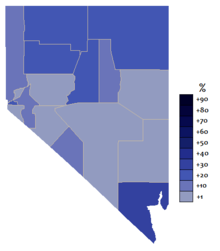Hispanics and Latinos in Nevada
Hispanic and Latino Nevadans are residents of the state of Nevada who are of Hispanic or Latino ancestry. As of the 2010 U.S. Census, Hispanics and Latinos of any race were 27.3% of the state's population.[1]
History
Francisco Garcés was the first European in the area,[2] Nevada was annexed as a part of the Spanish Empire in the northwestern territory of New Spain. Administratively, the area of Nevada was part of the Commandancy General of the Provincias Internas in the Viceroyalty of New Spain. Nevada became a part of Alta California (Upper California) province in 1804 when the Californias were split. With the Mexican War of Independence won in 1821, the province of Alta California became a territory—not a state—of Mexico, due to the small population. In later years, a desire for increased autonomy led to several attempts by the Alta Californians to gain independence from Mexico.
Jedediah Smith entered the Las Vegas Valley in 1827, and Peter Skene Ogden traveled the Humboldt River in 1828. As a result of the Mexican–American War and the Treaty of Guadalupe Hidalgo, Mexico permanently lost Alta California in 1848. The new areas acquired by the United States continued to be administered as territories. As part of the Mexican Cession (1848) and the subsequent California Gold Rush that used Emigrant Trails through the area, the state's area evolved first as part of the Utah Territory, then the Nevada Territory (March 2, 1861; named for the Sierra Nevada).[3]
Demographics

Hispanics of any race made 26.5% of the population.[4] In 1970, non-Hispanic whites made up 88% of the state's population.[5]
The principal ancestry of Nevada's residents in 2009 has been surveyed to be the following:[6]
- 20.8% Mexican
Nevada also has a sizable Basque ancestry population. In Douglas, Mineral and Pershing counties, a plurality of residents are of Mexican ancestry, with Clark County (Las Vegas) alone being home to over 200,000 Mexican Americans. Las Vegas is home to rapid-growing ethnic communities, including Spaniards. According to the 2000 US Census, 16.19% of Nevada's population aged 5 and older speak Spanish at home.[7] Las Vegas was a major destination for immigrants from Hispanic America seeking employment in the gaming and hospitality industries during the 1990s and first decade of the 21st century, but farming and construction are the biggest employers of immigrant labor. The Hispanic population in Las Vegas also includes people from Cuba, El Salvador, Puerto Rico, Peru, and the Dominican Republic.
References
- "Nevada QuickFacts from the US Census Bureau". Quickfacts.census.gov. 2011. Archived from the original on July 31, 2014. Retrieved January 22, 2014.
- "Explorers and Settlers in Nevada" (PDF). Washoe County School District. p. 2. Retrieved 2010-05-20.
- "Online Etymology Dictionary". Retrieved 2010-05-20.
- "Nevada QuickFacts from the US Census Bureau". Quickfacts.census.gov. Archived from the original on July 31, 2014. Retrieved January 17, 2013.
- "Nevada – Race and Hispanic Origin: 1860 to 1990". U.S. Census Bureau. Archived from the original on December 24, 2014. Retrieved January 17, 2013.
- Nevada – Selected Social Characteristics in the United States, 2009 American Community Survey 1-year Estimates, U.S. Census Bureau, 2009. Retrieved November 2, 2011.
- "Language Map Data Center". Mla.org. July 17, 2007. Retrieved July 31, 2010.